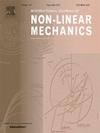Structural partitioning for parallel construction of geometric nonlinear reduced-order models
IF 2.8
3区 工程技术
Q2 MECHANICS
International Journal of Non-Linear Mechanics
Pub Date : 2025-03-18
DOI:10.1016/j.ijnonlinmec.2025.105092
引用次数: 0
Abstract
High-fidelity finite element models are widely used to predict the mechanical behavior of structures with complex geometries. While these models provide accurate results, they often require significant computational time, particularly when predicting nonlinear dynamic behavior. To address this, model order reduction techniques have been developed to reduce the computational time. However, constructing non-intrusive reduced-order models from high-fidelity finite element models still requires considerable computational time. This paper proposes a fully parallel process to accelerate the construction of geometrically nonlinear reduced-order models. In this approach, the structure is divided into multiple partitions, each assigned to a separate processor. The reduction basis for each partition ensures displacement consistency at partition interfaces without requiring additional modal coordinates at these interfaces. The parallel process operates without inter-processor communication, making it robust and straightforward to implement. It is compatible with various non-intrusive model order reduction techniques and achieves high computational efficiency. Notably, this approach introduces no additional errors, i.e., the reduced-order model constructed through the parallel process is identical to that obtained via traditional methods.
几何非线性降阶模型并行构造的结构划分
高保真有限元模型被广泛用于复杂几何结构的力学性能预测。虽然这些模型提供了准确的结果,但它们通常需要大量的计算时间,特别是在预测非线性动态行为时。为了解决这个问题,已经开发了模型降阶技术来减少计算时间。然而,利用高保真度有限元模型构建非侵入式降阶模型仍然需要大量的计算时间。本文提出了一种全并行过程来加速几何非线性降阶模型的构造。在这种方法中,结构被划分为多个分区,每个分区分配给一个单独的处理器。每个分区的约简基础确保了分区界面上的位移一致性,而不需要在这些界面上额外的模态坐标。并行进程运行时不需要处理器间通信,这使得它健壮且易于实现。它兼容多种非侵入式模型降阶技术,具有较高的计算效率。值得注意的是,该方法没有引入额外的误差,即通过并行过程构建的降阶模型与传统方法获得的降阶模型相同。
本文章由计算机程序翻译,如有差异,请以英文原文为准。
求助全文
约1分钟内获得全文
求助全文
来源期刊
CiteScore
5.50
自引率
9.40%
发文量
192
审稿时长
67 days
期刊介绍:
The International Journal of Non-Linear Mechanics provides a specific medium for dissemination of high-quality research results in the various areas of theoretical, applied, and experimental mechanics of solids, fluids, structures, and systems where the phenomena are inherently non-linear.
The journal brings together original results in non-linear problems in elasticity, plasticity, dynamics, vibrations, wave-propagation, rheology, fluid-structure interaction systems, stability, biomechanics, micro- and nano-structures, materials, metamaterials, and in other diverse areas.
Papers may be analytical, computational or experimental in nature. Treatments of non-linear differential equations wherein solutions and properties of solutions are emphasized but physical aspects are not adequately relevant, will not be considered for possible publication. Both deterministic and stochastic approaches are fostered. Contributions pertaining to both established and emerging fields are encouraged.

 求助内容:
求助内容: 应助结果提醒方式:
应助结果提醒方式:


